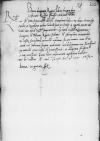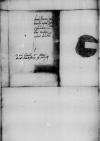List #785
Bona Sforza do Ioannes DANTISCUSCracow (Kraków), 1532-05-05
| odebrano Regensburg, [1532]-05-19 Rękopiśmienne podstawy źródłowe:
Publikacje:
| ||||||
Tekst + aparat krytyczny + komentarzZwykły tekstTekst + komentarzTekst + aparat krytyczny
Reverendo in Christo Patri paper damaged⌈[Reverendo in Christo Patri]Reverendo in Christo Patri paper damaged⌉, domino
Reverende in Christo Pater, sincere nobis dilecte.
Accepimus litteras S(trenuitatis) or S(inceritatis)⌈S(trenuitatis)S(trenuitatis) or S(inceritatis)⌉
Tuae datas 16 mensis Aprilis ex


 BCz, 3465, p. 228
BCz, 3465, p. 228